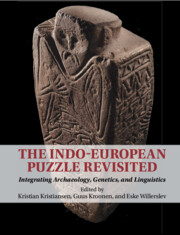Book contents
- The Indo-European Puzzle Revisited
- The Indo-European Puzzle Revisited
- Copyright page
- Contents
- Figures
- Tables
- Contributors
- Preface
- Introduction
- Part I Early Indo-European and the Origin of Pastoralism
- 2 The Yamnaya Culture and the Invention of Nomadic Pastoralism in the Eurasian Steppes
- 3 Yamnaya Pastoralists in the Eurasian Desert Steppe Zone: New Perspectives on Mobility
- 4 Proto-Indo-Anatolian, the “Anatolian Split” and the “Anatolian Trek”: A Comparative Linguistic Perspective
- Part II Migratory Processes and Linguistic Dispersals between Yamnaya and the Corded Ware
- Part III The Cultural and Linguistic Significance of Bell Beakers along the Atlantic Fringe
- Part IV The Bronze Age Chariot and Wool Horizons
- Part V Kinship Systems, Marriage, Fosterage, Free, and Unfree
- Concluding Reflections
- Index
- References
2 - The Yamnaya Culture and the Invention of Nomadic Pastoralism in the Eurasian Steppes
from Part I - Early Indo-European and the Origin of Pastoralism
Published online by Cambridge University Press: 29 April 2023
- The Indo-European Puzzle Revisited
- The Indo-European Puzzle Revisited
- Copyright page
- Contents
- Figures
- Tables
- Contributors
- Preface
- Introduction
- Part I Early Indo-European and the Origin of Pastoralism
- 2 The Yamnaya Culture and the Invention of Nomadic Pastoralism in the Eurasian Steppes
- 3 Yamnaya Pastoralists in the Eurasian Desert Steppe Zone: New Perspectives on Mobility
- 4 Proto-Indo-Anatolian, the “Anatolian Split” and the “Anatolian Trek”: A Comparative Linguistic Perspective
- Part II Migratory Processes and Linguistic Dispersals between Yamnaya and the Corded Ware
- Part III The Cultural and Linguistic Significance of Bell Beakers along the Atlantic Fringe
- Part IV The Bronze Age Chariot and Wool Horizons
- Part V Kinship Systems, Marriage, Fosterage, Free, and Unfree
- Concluding Reflections
- Index
- References
Summary
Between 3000 and 2500 BCE, populations derived genetically from individuals assigned to the Yamnaya archaeological culture migrated out of their steppe homeland eastward to the Altai Mountains and westward into the Hungarian Plain and southeastern Europe, an east–west range of 5,000 km across the heart of the Eurasian continent (Allentoft et al. 2015; Narasimhan et al. 2019). In Europe, their descendants created the Corded Ware and Bell Beaker horizons (Haak et al. 2015; Frînculeasa et al. 2015; Olalde et al. 2018), establishing a large part of the genetic ancestry in modern Europeans and probably their linguistic ancestry in the Indo-European language family as well (Anthony 2007; Reich 2018). The Yamnaya archaeological culture (or “cultural-historical community,” in Soviet archaeological jargon) has consequently become a focus of wide interest. One debated subject that is perhaps most relevant for understanding the outbreak of long-distance migrations is the nature of the Yamnaya pastoral economy – were they nomads? This essay addresses Yamnaya nomadism as an innovation that opened the Eurasian steppes to productive human exploitation. It does not consider nomadic pastoralism in other parts of the world. Because the Yamnaya culture is little known or understood by Western archaeologists, I begin with an overview of Yamnaya chronology and variability.
- Type
- Chapter
- Information
- The Indo-European Puzzle RevisitedIntegrating Archaeology, Genetics, and Linguistics, pp. 13 - 33Publisher: Cambridge University PressPrint publication year: 2023
References
- 1
- Cited by



